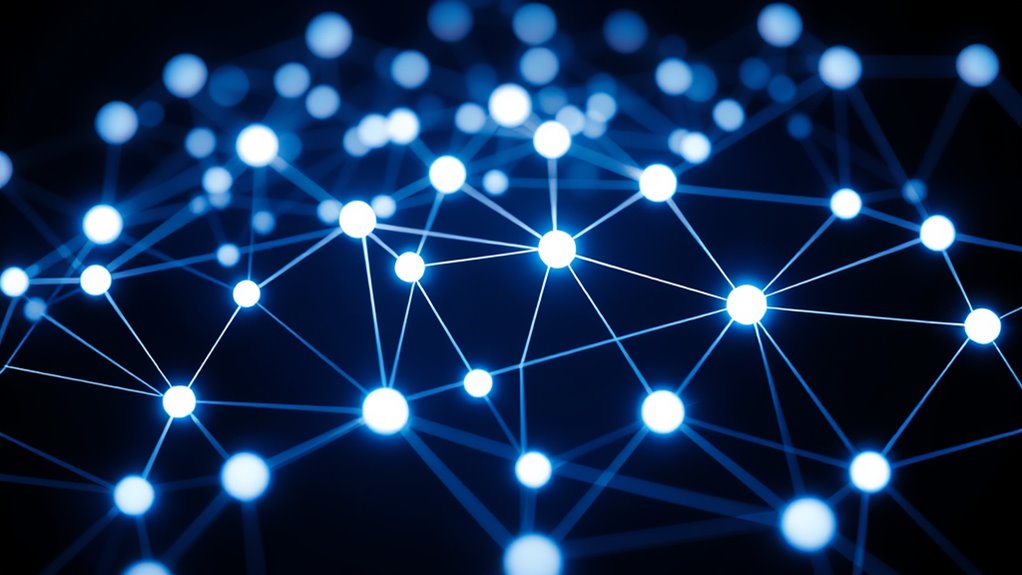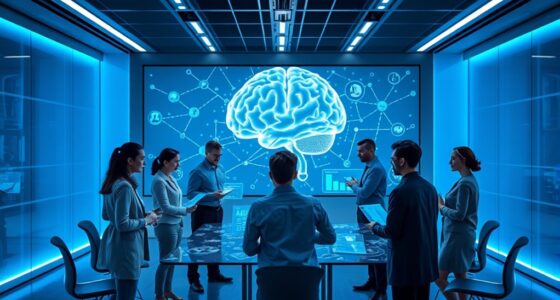Neural networks mimic the way the human brain processes information by using interconnected layers of neurons that recognize patterns and make decisions. They learn by adjusting internal weights through training methods like supervised learning, which compares predictions to actual outcomes. Activation functions control when neurons activate, shaping how well the network models complex data. Understanding these key components helps you see how neural networks become powerful tools for tasks like image recognition and language processing. Keep exploring to uncover more about how they truly work.
Key Takeaways
- Neural networks mimic brain functions by processing data through interconnected layers of neurons.
- They learn by adjusting internal weights based on data inputs and errors during training.
- Activation functions determine neuron responses, enabling the network to model complex patterns.
- Training involves feeding large datasets and optimizing weights using algorithms like gradient descent.
- Proper design of components enhances the network’s ability to recognize patterns and make accurate predictions.

Neural networks are a fundamental technology behind many modern artificial intelligence applications. When you start working with them, you’ll find that understanding how they operate hinges on grasping their core components and processes. At their heart, neural networks mimic the way the human brain processes information, allowing machines to recognize patterns, make decisions, and learn from data. The first step in making this happen involves training methods, which are the techniques you use to teach the network to perform specific tasks. These methods typically involve feeding the network large datasets and adjusting the internal parameters to improve its accuracy. During training, the network compares its predictions to the actual outcomes, calculates errors, and updates its weights accordingly. This process, often called supervised learning, helps the network refine its understanding over time. Without effective training methods, the network can’t learn efficiently, which is why choosing the right approach—like gradient descent or backpropagation—is essential. Additionally, understanding learning algorithms is crucial to optimize the training process and achieve better results.
Activation functions are another indispensable element in neural network operation. These mathematical functions determine whether a neuron should activate or stay dormant, effectively controlling the flow of information through the network. When you design a neural network, selecting the right activation function can greatly impact its performance. For example, functions like ReLU (Rectified Linear Unit) help the network learn complex, non-linear patterns by allowing neurons to output zero or a positive value, which accelerates training and mitigates issues like vanishing gradients. Other activation functions, such as sigmoid or tanh, are used in specific contexts where the output needs to be bounded between certain ranges, but they can slow down training due to their tendency to saturate. As you build and train neural networks, understanding how activation functions influence learning helps you optimize the network’s capacity to adapt to data. They serve as the non-linear decision-makers within the network, enabling it to model complicated relationships that linear models simply can’t capture.
In essence, the way you implement training methods and select activation functions shapes the effectiveness of your neural network. The training process tunes the network’s weights, while activation functions influence how well the network captures and generalizes patterns from data. By mastering these fundamental aspects, you can develop neural networks that are not only accurate but also efficient and robust. Whether you’re refining a model for image recognition, language processing, or predictive analytics, understanding these components gives you the control needed to improve performance and achieve your AI goals.
Frequently Asked Questions
How Do Neural Networks Handle Noisy or Incomplete Data?
When you feed noisy or incomplete data into neural networks, they handle it through techniques like noise filtering and data imputation. Noise filtering helps remove irrelevant or corrupted information, improving accuracy. Data imputation fills in missing values, ensuring your model can learn from incomplete data. By applying these methods, your neural network becomes more robust, making better predictions despite imperfect data. This process enhances overall performance and reliability.
What Are the Common Challenges in Training Neural Networks?
When training neural networks, you often face challenges like overfitting issues, where the model learns noise instead of patterns, and training complexity, making it hard to optimize. These issues can lead to poor performance on new data. To overcome them, you need to tune hyperparameters carefully, use regularization techniques, and make sure you have enough diverse data. Managing these challenges helps your network generalize better and improves overall accuracy.
How Do Neural Networks Compare to Traditional Algorithms?
You’ll find neural networks excel over traditional algorithms in feature learning, automatically discovering patterns in data without manual feature extraction. They adapt well through transfer learning, leveraging pre-trained models for new tasks, saving time and resources. Unlike traditional algorithms, neural networks handle complex, high-dimensional data more effectively, making them ideal for tasks like image recognition and natural language processing. This adaptability and ability to learn features give neural networks a significant edge.
Can Neural Networks Explain Their Decision-Making Process?
Imagine trying to read a secret code—neural networks face similar interpretability challenges. While they can make accurate decisions, transparency issues remain, making it hard for you to understand how they arrive at those choices. Neural networks don’t easily explain their decision-making processes, often acting like black boxes. This limits your trust and ability to interpret their outputs, highlighting the ongoing need for methods that shed light on their inner workings.
What Are the Latest Advancements in Neural Network Architecture?
You’re curious about the latest advancements in neural network architecture. Recently, transformer models have revolutionized the field by using attention mechanisms, allowing networks to weigh the importance of different data parts dynamically. This innovation improves performance in tasks like language processing and image recognition. These advancements enable your models to learn more efficiently, handle complex data, and deliver more accurate results, pushing the boundaries of what neural networks can achieve.
Conclusion
Now that you understand how neural networks weave information like an intricate web, imagine yourself as a skilled navigator guiding a ship through complex seas. These networks are your compass, transforming raw data into insightful decisions. With each connection, you reveal new horizons of knowledge, turning abstract patterns into powerful tools. Embrace this digital voyage, and let neural networks be your map—leading you confidently through the endless ocean of possibilities.









